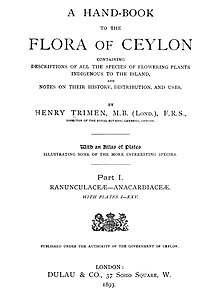Henry Trimen
Henry Trimen (born October 26, 1843 in Paddington , London , † October 16, 1896 in Kandy ) was a British doctor and botanist. Its botanical author's abbreviation is " Trimen ".
Live and act
Henry Trimen grew up in Paddington, London. He was the younger brother of the butterfly scientist Roland Trimen (1840-1916). He attended King's College School and from the autumn of 1860 the medical school at King's College London . He spent the winter semester of 1864 at the University of Edinburgh , where he was clinical assistant to Prof. John Hughes Bennet (1812-1875). In 1865 he passed the Bachelor of Medicine exams at the University of London with honors. He was employed as a doctor during a cholera epidemic that broke out in London shortly afterwards. However, he found his true calling in botany .
In 1864 Trimen joined the Botanical Society in Edinburgh. He was in contact with the Scottish botanist John Hutton Balfour . Together with William Turner Thiselton-Dyer he was active in the society of amateur botanists and in the botanical exchange club, where he also had contact with the botanist John Gilbert Baker . He then made the acquaintance of John Warren, the 3rd Baron de Tabley (1835–1895), who, along with WTT Dyer and Mr. Newbould, was one of his close botanical friends. In 1869 he received the post of assistant in the botany department of the British Museum . From 1872 to 1873 Trimen played a leading role in the Reformation of the Linnaeus Society , of which he had become a member in 1866. From 1877 to 1879 he held botany lectures at St. Mary's Hospital in London .
In 1879 he was appointed to succeed George Henry Kendrick Thwaites as director of the Botanical Garden in Peradeniya ( Ceylon ). Here he revised the presentation of the plants according to the natural system and according to a division into plants of the plains and plants of the mountains. He received visits from European scientists such as Henry Nicholas Ridley and Ernst Haeckel .
Trimen’s life's work was crowned by the publication of his “Handbuch der Flora Ceylon”, the last volumes of which were completed by Joseph Dalton Hooker using Trimen’s notes. Trimen’s work also focused on economic botany, that is, the research into optimal conditions for growing and harvesting colonial plants, especially cinchona bark trees . The botanist James Britten noted in an obituary:
- "It was fortunate that he was able to watch the decline of coffea arabica and the subsequent production of cinchona and cocoa , and above all that he could do everything in his power to promote the success of the current tea trade ."
Honors
The plant genus Trimenia Seem is named after him . from the family of the Trimeniaceae .
Works
- Together with William Turner Thiselton-Dyer . Flora of Middlesex: a topographical and historical account of the plants found in the county. With sketches of its Physical Geography and Climate, and of the progress of Middlesex botany during the last three centuries . Robert Hardwicke, London 1869 (digitized version)
- Together with Robert Bentley . Medicinal plants. J. & A. Churchill, London 1880
- Volume 1 (No 001-069) Ranunculaceae - Anacardiaceae (digitized version )
- Volume 2 (No 070–146) Leguminosae - Valeriaceae (digital copy )
- Volume 3 (No 147–227) Compositae - Thymelaceae (digitized version )
- Volume 4 (No 228-306) Artocarpaceae - Algae (digitized version ) . Index (digitized version)
-
A Handbook to the Flora of Ceylon. Containing descriptions of all the species of flowering plants indigenous to the island, and notes on their history, distribution, and uses . Dulau and Co., London,
- Volume 1, 1893 Ranunculaceae - Anacardiaceae (digitized version) , Figures I-XXV. 1893 (digitized version) ,
- Volume 2, 1894 Connaraceae - Rubiaceae (digitized version) ,
- Volume 3, 1895 Valerianaceae - Balanophoraceae (digitized version ) ,
- Volume 4, 1898 Euphorbiaceae - Naiadeae (continued by Sir Joseph Dalton Hooker ) (digitized) ,
- Volume 5, 1900 Eriocauloneae - Gramineae (continued by Sir Joseph Dalton Hooker) (digitized version) ,
- Volume 6, 1931 additional volume (by Arthur Hugh Garfit Alston (1902–1958)) (digitized version)
literature
- James Britten . The late Henry Trimen . In: The tropical agriculturist. A monthly record of information for planters of tea, cacao, coffee, palms, rubber, cinchona, sugar, fibers, cotton, tobacco, spices, camphor, rice, and other products suited for cultivation in the tropics . Colombo, Volume 20 (1900) No 1 (July 2, 1900), pp. 1–6 (digitized version)
- George Simonds Boulger . Henry Trimen . In: Dictionary of National Biography, 1885–1900, Volume 57 (digitized)
Individual evidence
- ↑ James Britten. The late Henry Trimen . Colombo 1900, p. 1 (digitized version)
- ↑ Lotte Burkhardt: Directory of eponymous plant names - Extended Edition. Part I and II. Botanic Garden and Botanical Museum Berlin , Freie Universität Berlin , Berlin 2018, ISBN 978-3-946292-26-5 doi: 10.3372 / epolist2018 .
Web links
- Author entry and list of the described plant names for Henry Trimen at the IPNI
| personal data | |
|---|---|
| SURNAME | Trimen, Henry |
| BRIEF DESCRIPTION | British physician and botanist |
| DATE OF BIRTH | October 26, 1843 |
| PLACE OF BIRTH | Paddington , London |
| DATE OF DEATH | October 16, 1896 |
| Place of death | Kandy |

